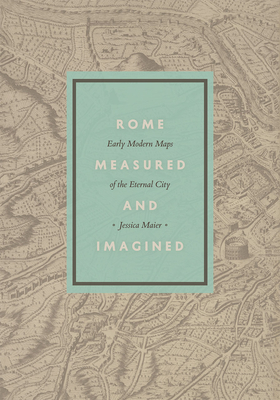
Rome Measured and Imagined: Early Modern Maps of the Eternal City
Description
At the turn of the fifteenth century, Rome was in the midst of a dramatic transformation from what the fourteenth-century poet Petrarch had termed a “crumbling city” populated by “broken ruins” into a prosperous Christian capital. Scholars, artists, architects, and engineers fascinated by Rome were spurred to develop new graphic modes for depicting the city—and the genre known as the city portrait exploded.
In Rome Measured and Imagined, Jessica Maier explores the history of this genre—which merged the accuracy of scientific endeavor with the imaginative aspects of art—during the rise of Renaissance print culture. Through an exploration of works dating from the fifteenth to the eighteenth centuries, her book interweaves the story of the city portrait with that of Rome itself.
Highly interdisciplinary and beautifully illustrated with nearly one hundred city portraits, Rome Measured and Imagined advances the scholarship on Renaissance Rome and print culture in fascinating ways.
Praise for Rome Measured and Imagined: Early Modern Maps of the Eternal City
"In this imaginative, meticulous book, Maier explores the world of early modern maps of Rome, from Alberti’s treatise on cartography (c. 1450) to the 18th-century enterprises of Nolli, Vasi, and Piranesi. Rome, “the quintessential palimpsest,” underwent grand reinvention in this period, and ritratti, or “portraits” of the city (as city maps and views were called) reflect not only changes in its urban framework but also shifts in artistic style, new attitudes toward antiquity, and contemporary improvements in cartography and surveying. In attempting to represent “the real Rome,” therefore, ritratti were both scientific and artistic, merging “measured rendering” with “creative expression.” Though Maier focuses on maps, such as those by Bufalini, Ligorio, Du Pérac, and Falda, she wisely expands her scope to address more essentially visual sources (late medieval images of cities) and key textual sources (Alberti and Raphael) and analyzes her evidence for artistic, scientific, intellectual, historical, and even commercial insights. The book is therefore as interdisciplinary as its material, useful for introducing students to its subject and serving as a fine example of interdisciplinary scholarship."
— CHOICE
"In Maier’s fine book on the mapping of Rome up to the eighteenth century, there is no echo of the everyday, often intensely litigated apportionment of urban space. Nor, as Maier notes, was there anything in early modern Rome similar to today’s tourist maps, used for orientation and quickly discarded. This was, she emphasizes, a mapping culture remote from today’s utilitarian concerns, although, as she also observes, the range of mapping technologies and formats available now is oddly reminiscent of the diversity in authorship, format and purpose of early modern maps of Rome."
— Imago Mundi
"A new, fresh introduction to the theme: a bright companion to a complex interdisciplinary topic, as well as a scholarly overview that is concise and original."
— Renaissance Quarterly
"This book traces the history of monumental printed maps, or 'city portraits,' of Rome throughout the early modern period. While not neglecting the gradual professionalization and growing accuracy of the maps produced, it differs from previous publications on this topic by also focusing on the "vision" these maps offer of the city, with all her timeless and unique qualities. To this end, Maier not only analyzes the prints themselves, but also discusses their makers, their audiences, and the contexts in which they were produced and appreciated. This leads her to consider these city portraits as a separate genre that peaked in the early modern period, balancing measurement and imagination in a way that is foreign to our modern understanding of cartography... We can now consider these city portraits as an early modern genre in its own right, that is best appreciated in its interaction with other scholarly, artistic, and literary genres. To see that maps of Rome, just like antiquarian treatises, drawings, or poems, also represent a certain perspective, this book is most valuable."
— H-Italy
“Maier’s sweeping survey of Renaissance efforts to represent Rome’s complex urban topography will be of great interest to historians of art, architecture, urban design, cartography, and print culture. Rome Measured and Imagined raises important questions of accuracy and representational license with implications that extend to how we conceptualize and navigate cities in the digital age.”
— John Pinto, Princeton University
“Rome Measured and Imagined is a much-needed and welcome contribution to the field. Maier succeeds admirably in subsuming the extensive scholarly literature on her subject, in closely examining Rome’s urban images, and in providing a rich and engaging account of the evolution of a genre.”
— Sarah McPhee, Emory University
“How do we create the portrait of a city? When that city is Rome, with its undulating hills and its endless layers of history, the challenge must involve deeper questions about time, space, structure, and civic destiny. Maier’s splendid, engaging book tracks the elusive art of portraying Rome on paper, both ‘the ineffable ancient city’ and ‘its tangible modern twin’, from the Eternal City's resurgence in the fifteenth century to its affirmation as a modern European capital in Giambattista Nolli's monumental urban plan of 1748, writing with a sprezzatura worthy of that sparkling era.”
— Ingrid Rowland, University of Notre Dame
“In lucid and evocative prose, Maier focuses early modern Rome through the different lenses of those who portrayed it in its most idealized manner. With the fascinating Rome Measured and Imagined, she brings to life not only the 1551 Bufalini map that is her center, but indeed the entire project of making and perusing maps. This visual history of city portraits shows us how Rome as it was has provided subject matter for innovative artists, antiquarians, printmakers, and engineers, each portrayal redolent of the technological values and visual preferences of its moment.”
— Evelyn Lincoln, Brown University
